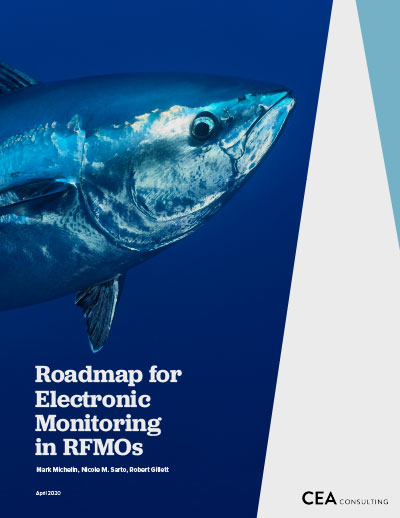Roadmap for Electronic Monitoring in RFMOs
The world’s tuna fisheries catch over US$40 billion worth of fish a year, providing employment for thousands and food for millions of people. Much of the catch occurs on the high seas, outside the territorial waters of any nation, and far from the authorities who are tasked with the oversight of these fisheries. To manage these highly migratory tuna species, governments came together to form Regional Fishery Management Organizations (RFMOs) to jointly decide on fishing regulations and policies.
One of the main responsibilities of RFMOs is to collect accurate data on fishing activities that can be used for scientific and compliance purposes. This is done through a variety of methods, including logbooks, landing reports, dealer reports, dock-side observers, and on-board human observers. Many purse seine tuna fisheries have 100% coverage with human observers, but for longline tuna fisheries observer coverage targets are often just 5% and many of these fisheries struggle to meet this low level of coverage. With limited at-sea monitoring, there is uncertainty about what longline vessels are catching, which makes it difficult to set and enforce management measures that protect the health of fish stocks and the economic productivity of the fishery.
There is growing interest in improving the monitoring of many of the world’s tuna fisheries, but it will be challenging to scale up human observer coverage much beyond current levels. However, the emergence of electronic monitoring (EM) – an integrated systems of video cameras, gear sensors, and positional sensors on fishing vessels – offers a solution to this challenge. But EM is much more than placing cameras and sensors on vessels. This hardware needs to be complemented by an EM program, which includes the standards and methods to collect, analyze, and store video of fishing activities and to share the results with authorized entities (e.g., managers, scientists, and vessel owners).
This report explores the necessary elements of a well-designed EM program and explores unique considerations for fisheries that are managed by an RFMO. It is not a prescriptive recipe for creating an EM program, but a discussion of some of the important elements and design options.
Bluefin tuna trade analysis
Pew Charitable Trusts has a dedicated campaign fighting overfishing of Mediterranean bluefin tuna. In advance of a major international meeting on tuna, Pew hired CEA to spearhead a three-month analysis of the trade data, using that data to demonstrate that the total traded volume was in excess of the legal harvest. The analysis was published in the peer reviewed literature and present to the regional fishery management organization to influence their decision making to reduce the quota.

